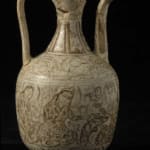Fatimid Lustre Painted Ewer, 910 CE - 1170 CE
Glazed Terracotta
5.5 x 11.5
LO.1289
Fatimid Egypt during the late 10th and early 11th century witnessed a significant evolution in the decoration of lustreware vessels. The depiction of human figures begins assuming a more significant...
Fatimid Egypt during the late 10th and early 11th century witnessed a significant evolution in the decoration of lustreware vessels. The depiction of human figures begins assuming a more significant role and scenes are gradually becoming more elaborate with the depiction of everyday activities. These lustre-painted ceramics represent the largest corpus of Islamic figural art that has come down to us from Fatimid Egypt. Scholars have often argued that the iconography of lustre ceramics from this period derives from a repertoire of Fatimid court painting, now entirely lost. The existence of several restaured and reconstructed bowls and of countless fragments from various urban regions of Egypt has also led scholars to conclude that the users of such lustre ceramics were more likely an urban elite, rather than the court. Around 1170, the lustre technique spread from Syria to the Iranian city of Kashan, where this ewer was made.
Lustre ewer with ovoidal body resting on a medium-height foot-ring; long flaring spout and tall raised neck, damaged on the side of the spout. An L-shaped handle, decorated by abstract motifs, connects the shoulder to the rim of the vessel. The surface of the ewer is completely covered by a decoration which clearly displays how Iranian potters used lustre just for the outlines of human figures and for the tracing of particular details. These figures although surrounded by floral and geometric patterns, represent the main ornamental subject of the composition, and are depicted in lustre against a white background. On both sides, two groups of three seated and richly adorned figures, a female figure in the centre is holding a ewer with her right, is in the process of pouring to the bowl extended by the right hand of the male figure opposite. A third seated female figure balances the arrangement of the composition.
Lustre ewer with ovoidal body resting on a medium-height foot-ring; long flaring spout and tall raised neck, damaged on the side of the spout. An L-shaped handle, decorated by abstract motifs, connects the shoulder to the rim of the vessel. The surface of the ewer is completely covered by a decoration which clearly displays how Iranian potters used lustre just for the outlines of human figures and for the tracing of particular details. These figures although surrounded by floral and geometric patterns, represent the main ornamental subject of the composition, and are depicted in lustre against a white background. On both sides, two groups of three seated and richly adorned figures, a female figure in the centre is holding a ewer with her right, is in the process of pouring to the bowl extended by the right hand of the male figure opposite. A third seated female figure balances the arrangement of the composition.



